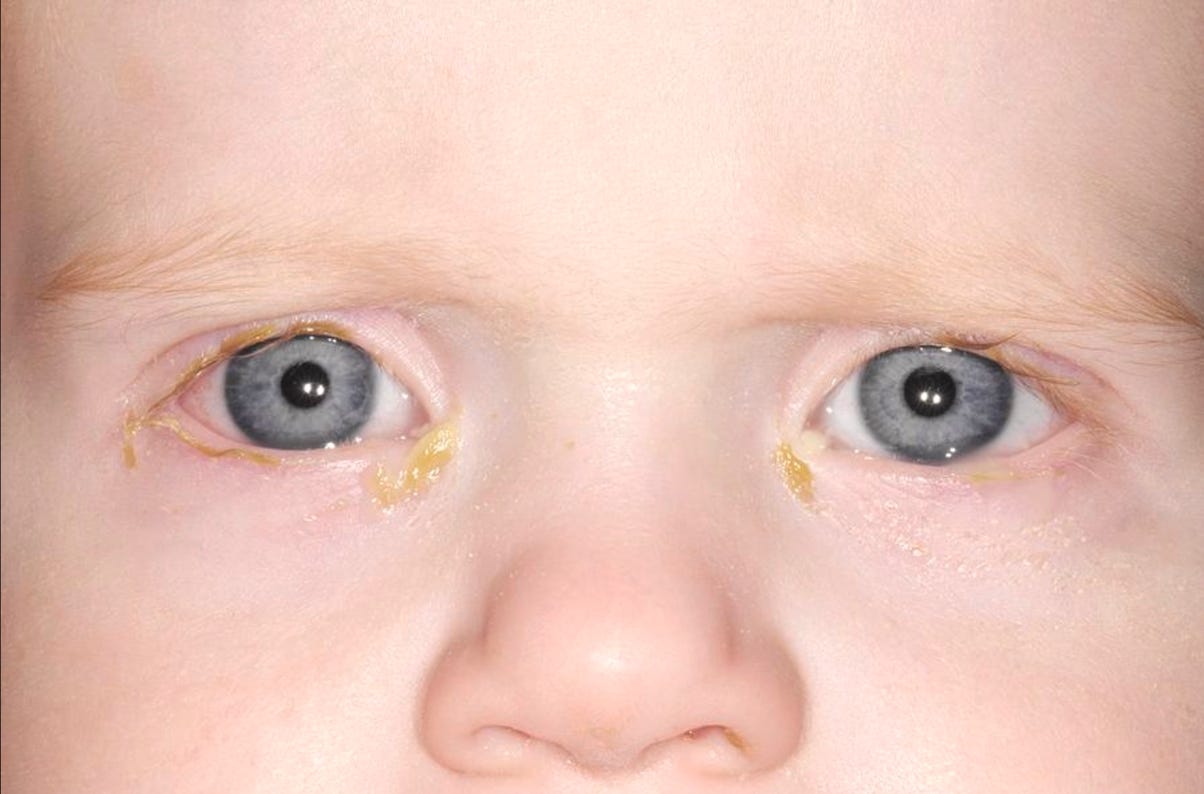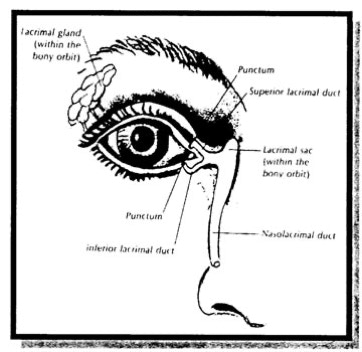PINKEYE
WHAT IS IT? Pink eye is a layman's term for a number of different medical diagnosis. It just means that there is an eye infection. One or more of the following will be present in pink eye: the eye ball itself may be pink or red, there may be a small to large amount of clear, yellow or green discharge that may mat the eye shut in the morning, the skin of the eyelid may be pink or red and there may be swelling of the eyelid.
NOTE: clear discharge, itchy eyes that are pink usually means allergies, not infection. Oral medicines do not help this. Cool compresses help, but allergy drops are needed to help this condition. You probably should discuss this with the office also. When most people say pink eye, they mean bacterial conjunctivitis, which has yellow discharge, no itching, no pain and is what this page is mainly about.
WHAT CAUSES IT? In infants the usual cause is a blocked tear duct. The tear duct is that knot you feel at the inside corner of your eye. This duct drains tears from your eye into the nose. This is why you get a runny nose when you cry. A blocked tear duct results in too many tears in the eye. When these tears lay in the eye, they may become infected causing a pink eye. Sometimes the tear duct itself becomes infected first and this will look like a red swelling where this knot at the corner of the eye is.In older children and sometimes in infants, the pink eye is caught from another child. Pink eye in these cases is usually viral, but may be bacterial. Pink eye is very contagious especially with the way children are constantly touching their eyes and each other. Pink eye usually shows up within 24 hours of contact and gets very impressive looking, very quickly.
HOW DO YOU TREAT IT? Most pinkeye will resolve with warm compresses alone. Doctors often give a prescription for eye drops. You may have also receive a oral antibiotic if your child's infection is more severe or if your child also has an ear infection. First lets go over the eye drops. You will need to do the following steps 4 times a day for 5 days.
- Wash your hands
- Place a warm wash cloth over the eyes as a warm compress
- Use the wash cloth to wipe off the mucus in the eye
- Place the wash cloth in the dirty clothes and don't reuse it until it's washed
- Massage the tear duct if you think its blocked ( your child will have almost constant tearing with clear tears and will be under 4 months of age )
- Wash your hands again, because pink eye is very contagious and you may spread it
90% of PINK EYE will go away with the warm compresses alone, but few respond to the eye drops alone, therefore make sure to do the warm compresses also.
This part only needs done in infants with blocked tear ducts:
The tear duct should be massaged by placing your little finger in the corner of your child's eye in the same place that you felt the knot in the corner of your eye. With medium pressure, press on this area in a downward motion about 10 times on each side. Remember you are trying to milk the tears along the duct, even though this area is only about 1/4 to 1/2 an inch long in your child.
WHAT ARE THE COMPLICATIONS? Pink eye is sometimes associated with an ear infection. If your child did not have it when you saw the doctor, then you must watch for the symptoms. Symptoms of an ear infection include a fever over 101, ear pain and worsening cold symptoms. It is not very common, though, to get an ear infection after you see the doctor.
The infection may worsen and become a cellulitis of the eye lid or eye itself. Symptoms of this include:
red eye lid (not a pink eyelid as this is normal with this infection)
blurry vision
eyes not moving together
eye lid swelling (like its swelling shut, a little swelling in the morning is normal)
headache
fever over 101
HOW DO YOU PREVENT IT? If you child is an infant and the doctor told you that your child may have a blocked tear duct, then you may prevent further infections by massaging the tear duct. Simply massage the tear duct several times at each diaper change or about 4 or more times a day. Make sure to wash your hands first and change the diaper after massaging the tear duct. Blocked tear ducts usually go away on their own by 3 to 6 months of age.
If your child did not have a blocked tear duct, then make sure that your child is following the good hygiene that you have been teaching him or her. Make sure they wash their hands often, don't touch their eyes or nose very much and try not to share tears or nasal mucus with their playmates.
WHEN TO CALL THE DOCTOR? If you think your child has pinkeye, then follow the above treatment plan without the drops and watch for the complications. If you see any of the complications, then call the doctor right away. If you don't see improvement with the compresses, then call the doctor. Your doctor may call in the eye drops or might need to see you in the office. Each case is different and whether we see you or call the medicine in depends on the individual situation.
HOW LONG IS MY CHILD CONTAGIOUS? There is various opinion on this and it actually depends on if its bacterial or viral and the type of treatment. Since a culture is usually not necessary to treat the infection, then we usually don't know which one you have. As a general rule, I would isolate your child until the eye looks normal and there is no discharge in the eye. This usually takes 3 to 5 days. Remember that pinkeye is about the most contagious thing we see in kids.


